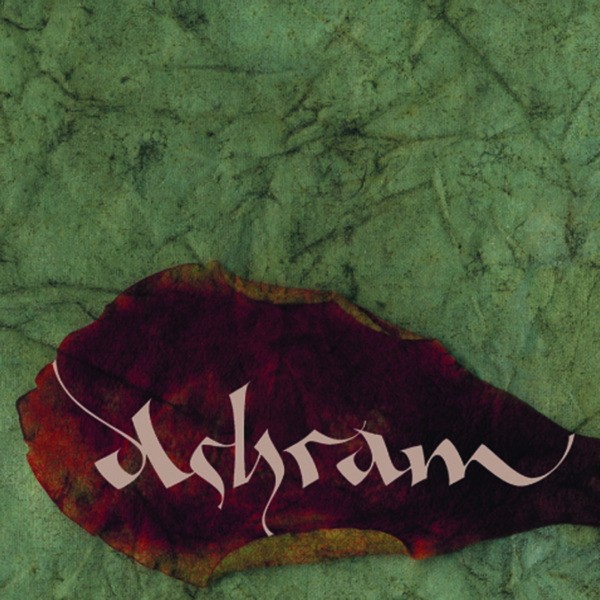CD front cover of the album Ashram (2002) by Ashram, a neoclassical band from Italy
Following up on our latest article entitled Rare Earth Deposits: A Simple Means of Comparative Evaluation, Toronto-based Secutor Capital Management Corp. has initiated coverage on Commerce Resources Corp. on April 28, 2014.
Secutors analysts, geologist Liliana Paoletti and Arie Papernick, value Commerces Ashram REE Project in Quebec with an after-tax NPV of $1.44/share, a difference of 747% from its current share price of $0.17. Their 28 page report also includes a compelling case for higher REE prices in the foreseeable future by discussing supply and demand, and shedding light into the strategic paramountcy for the western world not only to secure future REE supply but, more importantly, to establish its own processing facilities outside of China.
Below we present excerpts from Secutors analysis:
The Chinese are likely struggling with their rare earth assets due to decades of inefficient, wasteful processing and non-existent environmental standards. No one really knows the full extent of the damage done by Chinas rare earth industry, and the shape these mines are in. Could it be that China will have to secure both a supply of heavy rare earths and a supply of light rare earths sooner than the rest of the world anticipates?
As China begins to look elsewhere to secure new REE feedstock, perhaps the rest of the world should do the same, given the strategic importance of these metals to military and to industry. To that end, why not look to Quebec?
Rare earth projects outside of China with feasible metallurgy and exposure to the critical rare earth oxides are quite limited. Many rare earth juniors, though they may have this exposure, are not capable of producing a saleable mineral concentrate, making their projects extremely risky. Commerce is one of the most advanced juniors simply because it meets this key development requirement, even though a feasibility study has not yet been completed.
Considering the stage of development that Commerce is in at the very moment, we assess the time being ripe for a joint-venture partner or off-taker to strategically transact with Commerce, especially in light of current low market valuations and that Commerce succeeded recently (December 2013) to advance to one of the worlds few REE development projects with a chance to be brought into production no matter if REE prices remain low.
Commerce Resources is one of the most advanced REE juniors in regards to metallurgy, which in the REE space, is everything.
Commerce is currently evaluating several options for end-products including a mixed REO concentrate, a mixed REC concentrate, and a partial separation. Ultimately, the end-products Commerce produces will depend on the needs of a JV partner or other strategic partner. REE processors, such as Rhodia, would look to buy REO concentrates, whereas end-users are more interested in buying specific oxides.
FerroAtlantica, a Spanish multinational that is one of the worlds largest producers of silicon metals, plans to build a $375 million silicon plant in Quebec that is excpected to start operations in late 2016. FerroAtlanticas Director General said that very favourable conditions attracted the company to Quebec including discounted rates for hydroelectricity, a 10 year tax holiday, and financial support from Investissement Quebec which could amount 5-10% of the projects capital costs.
Could a similar deal be initiated between the province and a rare-earth processor?
As discussed, due to the Wests complacency to accept cheap resources from China, as well as a lack of vision for the long-term, there are very few rare earth processing facilities located in the western world. Rhodia, part of the Solvay Group, is one of the few companies outside of China that has the technology to separate, purify, and produce rare earth intermediate products. Since a number of rare earth deposits are located in Quebec, such a deal would be positive in establishing an integrated supply chain outside of China, provided that the deal is supported by provincial and federal governments in terms of capital and regulations.
Secutor explains that demand for REEs will follow once supply has been secured:
A key issue dampening demand for both light and heavy rare earth metals is the scarcity of a reliable, stable, and secure supply. The probability of a supply disruption from China may be fairly low, although, if such an event were to occur, the economic and defense consequences would be severe. Due to this risk, it is understandable that manufacturers are hesitant to invest serious money into developing product lines that use rare earth materials... The lack of a secure supply of rare earths is a problem, especially as newer and better technologies are developed that require the use of these exotic metals. End-users will need to have confidence in their supply chains before new and improved applications requiring rare earth metals can be developed and commercialized.
Lynas and Molycorp were the first companies to bring into production REE deposits outside of China in recent years.
The largest cost of any REE project is processing, and a good portion of processing costs is acid consumption. Processing costs are best reduced by upgrading the ore into a high grade mineral concentrate, reducing the amount of material that must be treated downstream. Commerce is able to reduce the mass of the ore by 97% on-site, producing a mineral concentrate of 43.6% total rare earth oxide (TREO) at a recovery of 70.7%. For comparison, Chinese refineries process feedstock from non-ionic clay deposits grading over 30% TREO with recoveries of over 60%. Molycorp and Lynas are also capable of producing mineral concentrates in excess of 30% TREO. Therefore, it appears that this capability is a prerequisite for production; however, this is where most junior mining companies struggle although it is the most crucial production criteria. Commerce is one of only two REE juniors, that we know of, that are able to produce a higher than 30% TREO mineral concentrate.
Sydney-based Lynas spent around A$1 billion on a REE processing plant in Malaysia and most recently announced plans to defer some debt repayments and sell as much as A$40 million in shares. Lynas said in March it would need more funds after its loss widened. Lynas share price has lost 57% in 2014 already (-78% in last 12 months) and is the worst performer this year among a Bloomberg Index of 11 rare earths producers and explorers. While Lynas has pre-sold most of its production to Japanese Sojitz Corp., US-based Molycorp essentially became a Chinese company after its merger with NeoMaterials in 2012. Molycorps processing facilities are predominantly based in China.
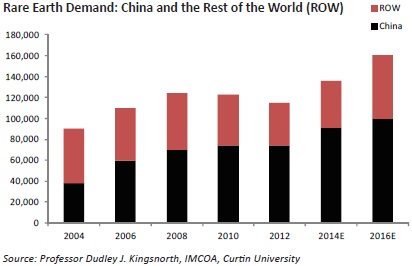
If the world is looking to diversify its rare earth supply, does it change anything to mine and process the raw materials in the US, ship these to China for additional down-stream processing, and then ship these products to the rest of the world, including back to the US?
China tried to acquire Molycorp in 2005 and Lynas in 2009, but was blocked by both the US and Australian government.
Perhaps Chinas intent was solely to protect its monopoly on the industry, however, it is important to keep in mind that China has a history of thinking long-term. Could it also be thinking of its rare earth supply for domestic consumption? In either case, developing additional mine capacity for the REEs is only a part of the solution. In order to truly diversify supply, down-stream processing facilities must be constructed outside of China to fulfill growing demand for REEs.
China does not have an unlimited amount of feed stock for its rare earth processing industry, and the fact that it is beginning to sign MOUs with junior exploration companies demonstrates this concern. China may be getting nervous about its domestic supply and it is its own largest customer.
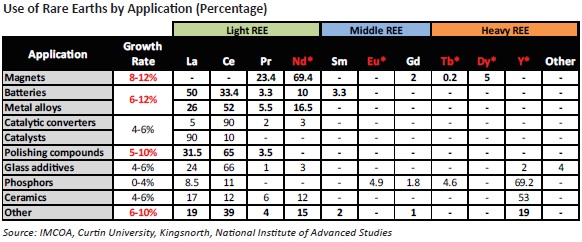
REE production from China, Molycorp and Lynas is dominated by cerium and lanthanum, which typically make up 75% of a REE deposit and thus are in greatest supply and have one of the lowest price values of all REEs. In 2013, cerium accounted for 40% of total REE consumption.
Molycorps bastnasite ore consits of 49% cerium. While the market anticipates cerium and lanthanum supply to increase significantly over the next years with Molycorp and Lynas ramping up to full production, Secutor arguments that both prices may not decrease further as demand may increase even stronger.
Though Ashrams REE distribution is 26% lanthanum and 46% cerium, these metals account for only 5% and 8%, respectively, of the ores value. Praseodymium, neodymium and europium collectively account for 72% of the rock value, despite being only 22% of the rock by tonnage. Furthermore, Ashram contains the rare earth elements needed by industry. Though many perceive heavy rare earth oxide (HREO) dominated deposits to be more favourable economically, only three of the heavy rare earth elements (HREEs) have ready markets. These are terbium, dysprosium, and yttrium. The remaining, erbium, holmium, thulium, ytterbium, and lutetium, are small, niche markets. As demonstrated, a significantly higher quantity of light and middle rare earths will be required in the higher growth markets, including magnets and batteries.
Although not a heavy rare earth deposit, Ashram still hosts appreciable amounts of Tb, Dy, and Y. In the end, it is never advantageous for a deposit to have the right rare earth distribution but the wrong mineralogy. The mineralogy determines the feasibility of a project.
While Lynas and Molycorp are struggling hard to stay profitable during current low REE prices, Commerce would not have such problems as being protected uniquely from low REE prices thanks to its well-balanced REE distribution, especially in the critical rare earth elements (CREEs) which are in shortest supply yet highest demand (Nd, Eu, Tb, Dy, and Y).
Nd (an LREE) is anticipated to be 24% of the overall REE market demand by 2015, and is currently a larger market than all the HREEs combined. Furthermore, Eu (also an LREE) has the highest dollar value per kg of any REE. This is one reason why Commerces Ashram Deposit is my top pick in the REE space, because it has a well-balanced distribution that hosts significant Nd and Eu, as well as appreciable amounts of Tb, Dy, and Y. This means a more balanced weighting of the primary pay elements (CREEs) that act as an internal hedge to a price drop of one or more of those elements.
There are over 200 REE-bearing minerals, yet only four of these have ever been a source of material supply to the market, and thus dominate commercial processing, both presently and historically. These are monazite, bastnaesite, xenotime, and loparite. However, many rare earth deposits contain multiple REE-bearing minerals contributing to the overall grade, and many of these have never been commercially processed, leading to complicated flow sheets, and high processing and R&D costs.
Significantly, although heavy rare earths are in demand for the Chinese, they only have the capability to liberate HREEs hosted by xenotime, not those hosted by the myriad of exotic minerals making up many of the most well-known HREE deposits.
The reason why Commerces metallurgy is so advanced is because the REE mineralization at Ashram is contained within conventional REE-bearing minerals, and therefore the metallurgy is well understood. Furthermore, waste rock and mine tailings at Ashram are not considered to be acid-generating or radioactive.
VALUATION
In Secutors valuation, an after-tax NPV of $1.44/share was calculated for Commerces Ashram Project in Quebec, which is +747% from its current share price of $0.17.
The calculation was based on the July 2012 PEA results, including project finance (100% debt plus $28 million in equity for completion of the pre-feasibility study and feasibility study), using a 10% discounted cash flow model and March 2014 REE prices.
Although REE prices are much lower than in mid-2012, the Ashram Project remains robust thanks to its balanced REE distribution giving it a better chance of surviving price weaknesses, as Secutor analyses, and which is in stark contrast to other producers, first and foremost Molycorp and Lynas, struggling to remain profitable at current low market prices.

A number of factors are expected to significantly improve this valuation with the upcoming pre-feasibility study:
1. The 2012 PEA and Secutors DCF model are both based on a 10% mineral concentrate.
Since Commerce can now produce a higher than 40% mineral concentrate, Ashrams OPEX and CAPEX should be reduced markedly.
2. The 2012 PEA evaluates an onsite hydrometallurgical plant, yet a recent trade-off study indicates that a offsite location east of Montreal is more economic and will be used as the base case in the upcoming PFS.
It makes sense for Commerce to consider this option given that it can achieve a high-grade mineral concentrate with 97% mass reduction, notably lowering transportation costs.
3. Ashrams economics are likely to be improved by including fluorspar as a by-product, because a 94% fluorite concentrate could be produced with minimal impact to OPEX and CAPEX as it would follow the exact same flow sheet requiring no additional processing.
Fluorite sells for approximately US$380 per tonne and has a ready market, opening up the possibility for a future off-take agreement.
4. The 2012 PEA assumes that Commerce will bear 100% of the infrastructure development in Quebec. The costs of the roads to be built have been reduced significantly since the 2012 PEA which optimizations will be included in the PFS.
The Liberal Party, the original proponents of the strategy, have been elected and Philippe Couillard, Quebecs premier, made Plan Nord an important part of his electoral platform. Commerces proposed road route is in line with Plan Nords development plans.
5. With a mining rate of 4,000 tpd and a cut-off grade of 1.25% TREO, Ashram has a mine life of 177 years. Commerce is completing a 1,000 to 1,500 m infill drill program at the moment in order to upgrade the inferred resource to measured and indicated. The 2012 inferred resource (220 million tonnes) is 8 times larger than the measured and indicated resource (29 million tonnes).
Drilling encountered less in-pit waste rock at surface than was previously modelled in the PEA, lowering the strip ratio, increasing the resource, and reducing costs. Moreover, a couple of step-out holes intersected an extension of the deposit 60 m to the northwest.
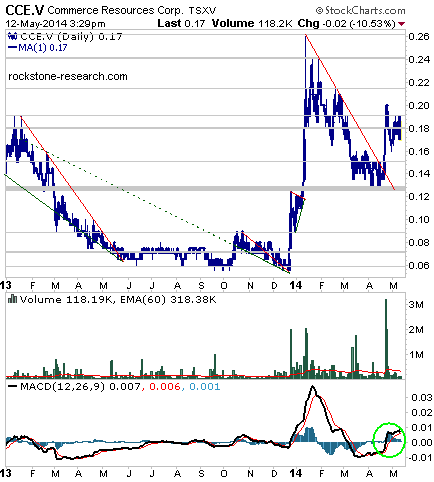
Link to live chart (15 min. delayed): http://scharts.co/1eXc6Vt
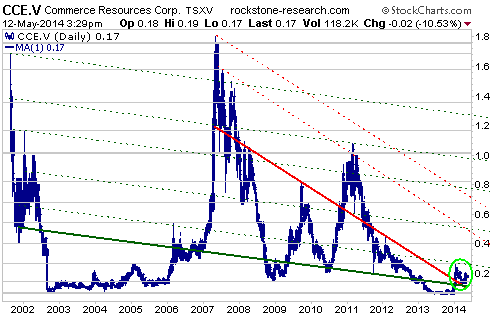
Link to live chart (15 min. delayed): http://scharts.co/1eXbG1o

Disclaimer:
The author, Stephan Bogner (Dipl. Kfm., FH), owns shares of Commerce Resources Corp. and thus would profit from a share price appreciation, whereas the author may sell those any time without notice. Neither Rockstone Research nor the author was remunerated or instructed by Commerce Resources Corp. to produce or publish this content. However, please read the full disclaimer within the full research report (available as a PDF below) as a conflict of interest exists with Zimtu Capital Corp. and none of this content is to be construed as a "financial analysis" or "investment advice".
